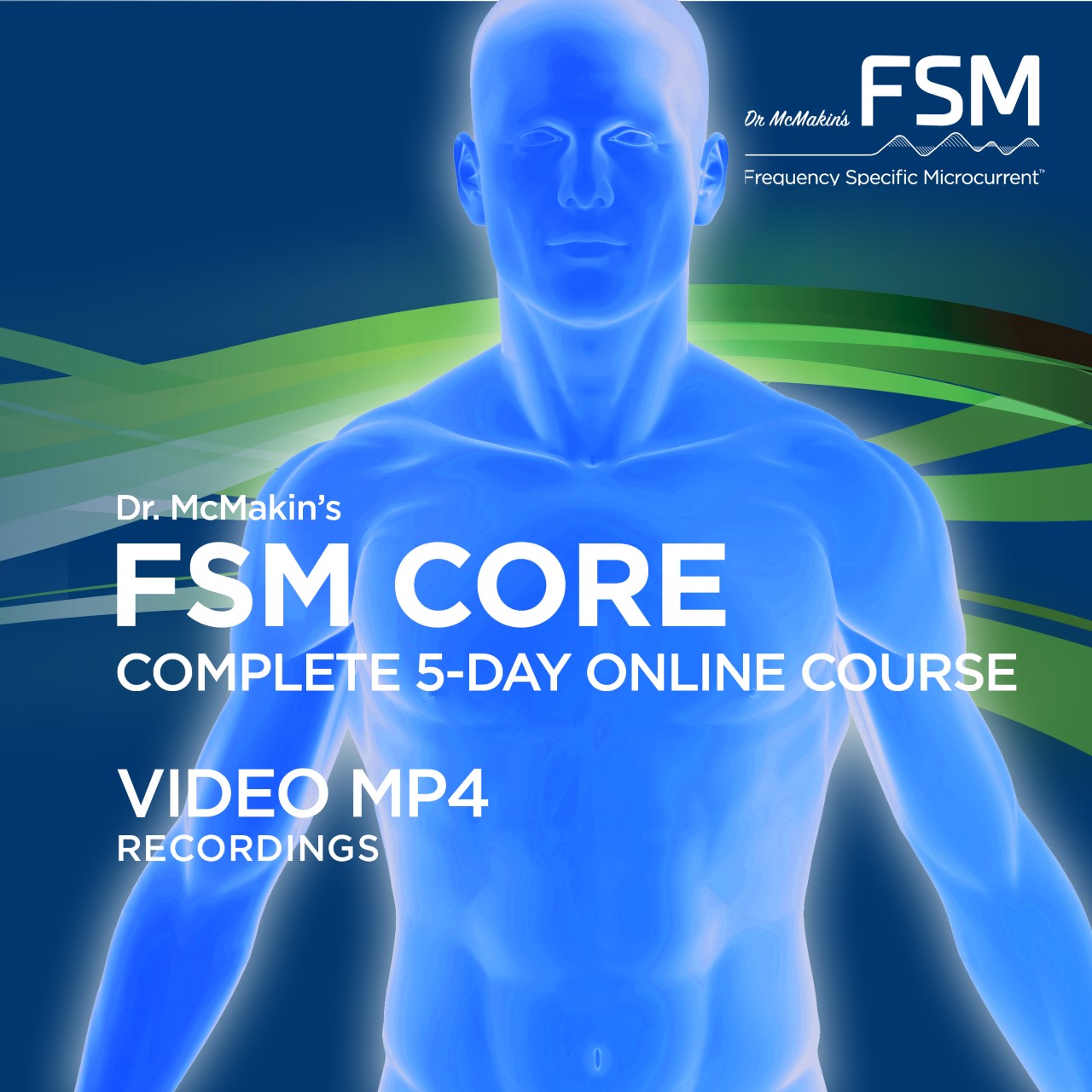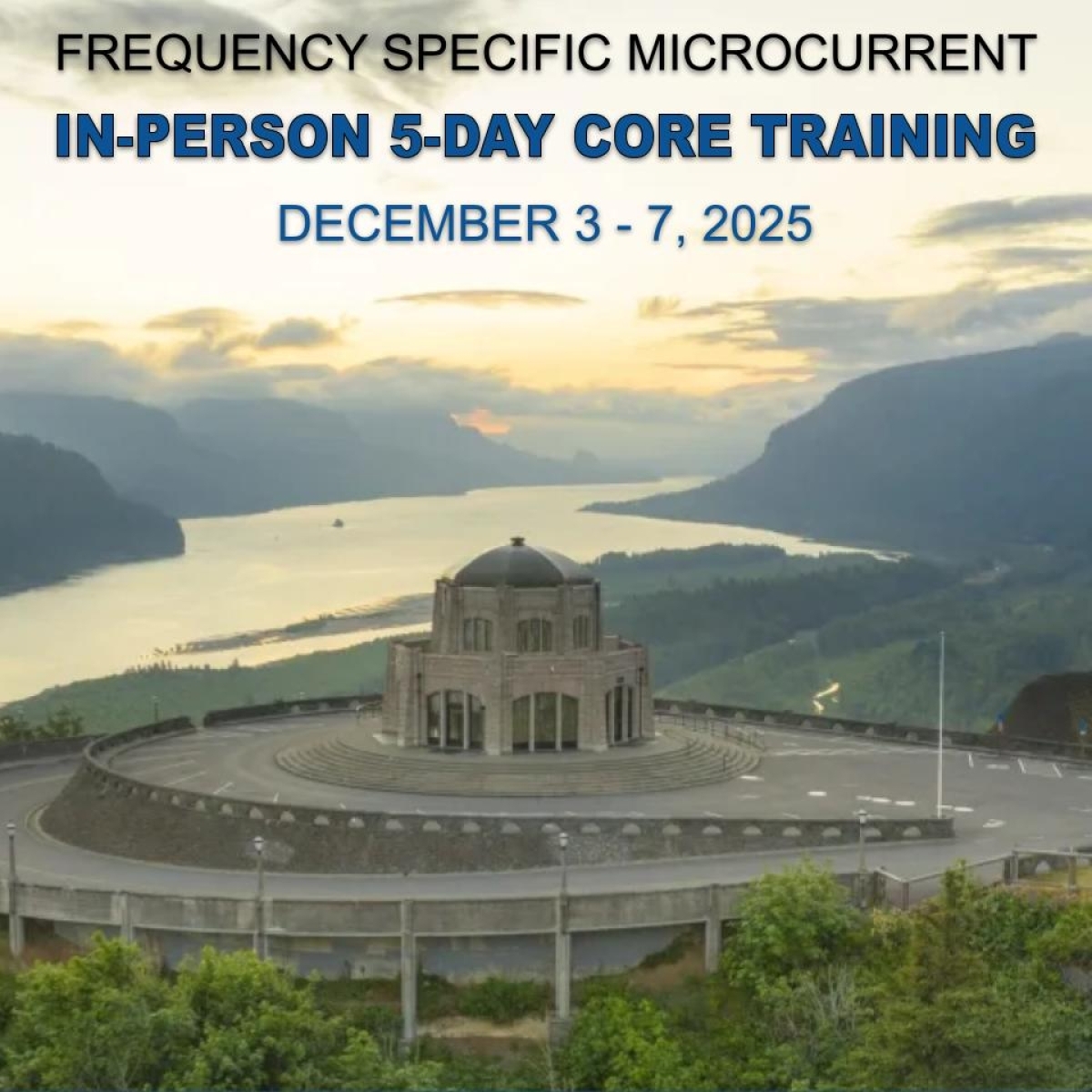FSM 5-Day Core Syllabus
Course topics, goals, and objectives:
The course covers basic microcurrent information and the use of specific frequencies and protocols thought to address specific tissues and conditions based on the principles of biological resonance. The first part of the course focuses on the frequencies and protocols used to treat chronic myofascial pain, new injuries and injuries less than six weeks old, discogenic pain, post-concussive syndrome, and neuropathic pain. The third day of the course focuses on the frequencies needed to treat visceral conditions and functional medicine applications.
At the end of the class:
1. Students will independently operate a two-channel 3 digit specific microcurrent device. They are observed to be able to turn the unit on, and modify the frequencies, amperage, wave slope, and polarity functions.2. Students will independently position and place the contacts on the patient and choose appropriate protocols for cervical, thoracic, and lumbar radiculopathies and diabetic neuropathies.
3. Students will demonstrate at least two protocol selections for low back pain caused by facet joint inflammation.
4. Students will explain at least three key contraindications, precautions to treatment, or known side effects of using Frequency Specific Microcurrent.
5. Given one sample patient, students will distinguish between pain caused by spinal facet joints, discs, and lax ligaments.
6. Students will independently choose at least two appropriate protocols for each of the following conditions: cervical, thoracic, and lumbar radiculopathies and diabetic neuropathies.
The goal of Frequency Specific Seminars is to educate all of our students so that they will be able to accomplish these objectives independently within the scope of their own practice.
*These protocols and statements have not been evaluated by the FDA. Resonance Therapy is not intended to diagnose or treat any disease or condition and is to be used as an adjunct therapy.
1. Introductions/Introductory Information – 2 Hours
Proposed mechanisms of action for FSM
The basic science behind resonance effects
Creating a stable state for lasting effects
2. Basics of FSM – 2 Hours
How to set up the device, effects of the current
Frequency conventions for FSM
Basic treatment strategies for myofascial trigger points
Published papers and data supporting use in myofascial trigger points
Pregnancy precaution
Frequencies and data supporting use to remove or soften scar tissue and adhesions
Frequency sequence strategy for treating myofascial pain and trigger points
3. Setting up the device and programming – 1 Hour
Demonstration of the use of the manual device
Current and frequency applied to the group
Going over the differences in an individual’s ability to detect differences between frequency effects
Demonstrating effects of 6 different two-channel frequency combinations
4. Frequencies and protocol sequences for myofascial pain – 2 Hours
How to tell if a frequency is correct or if it is working
Protocol for treating muscle and fascia in myofascial pain
Includes contact placement and current flow directions
5. Practicum – 1 Hour
Treating myofascial pain in the neck and shoulder with the patient prone
The role of the subscapularis in shoulder pain and impingement
Treating adhesions
6. Diagnosis and treatment protocols for disc-generated pain – 2 Hours
Protocols for acute, subacute, and chronic disc disease
Exercise Protocols for disc pain patients
7. Differential diagnosis of acute and chronic facet joint generated pain – 2 Hours
Protocols for acute and chronic spinal facet joints as perpetuating factors in myofascial pain
8. Differential diagnosis of ligamentous laxity, how to recognize it, and when and how to treat it – 2 Hours
Recognize and treat alar ligament instability and dural adhesions at CO-C1 – 2
Protocol for ligamentous laxity as perpetuating factor in myofascial pain
9. Recognizing and treating visceral perpetuating factors in myofascial pain and trigger points – 1.5 Hours
10. Treating extremity joints – 1.5 Hours
Treating the shoulder and the knee
Treating arthritis in any joint
Treating myofascial pain in TMJ
11. Introduction to the available microcurrent equipment useful for FSM practitioners – 1 Hour
Practical considerations in choosing equipment for any particular practice
12. Supine Cervical Practicum – 1 Hour
Treating the neck and shoulders with the patient in the supine position
Review of the facet, disc, and ligament laxity contributions to cervical spine myofascial pain and dysfunction
13. Treating Injuries and trauma in week 1 to week 6 – post-injury including post-operative pain and fractures – 1.5 Hours
Frequency protocols, precautions, and treatment considerations in sub-acute injuries
Protocols for subacute trauma from week 2 to week 6
Differential diagnosis of shingles when it presents so that it appears to be a new injury
Treatment protocol for shingles
14. Management and treatment protocols for acute injuries – 2 Hours
Protocols for acute trauma in the first week after injury
Protocols for athletic injuries
Differential diagnosis and treatment of shingles when it presents as if it is a new injury
Protocol and published paper on prevention of delayed onset muscle soreness
Protocol for post-operative care as a new injury
Protocol to enhance healing in acute fracture
Protocol for healed fractures that remain painful
Protocol for plantar fasciitis
15. Supine Lumbar Practicum – 1 Hour
Treating the lumbar spine with the patient in the supine position
Reinforcement of visceral contributions to myofascial pain in the lumbar spine
Review of the mechanics and considerations in facet and disc contributions to lumbar spine dysfunction
16. Introduction to treating the nervous system with FSM – 2 Hours
The basic organization of the central nervous system
Frequencies for the nervous system
Concepts in treating concussion, TBI, and MBTI
Frequencies associated with pathologies for CNS and ANS dysfunction
Review of functions of different brain areas
Treatment protocol for post-concussive syndrome
Treatment protocols for sub-acute and chronic neurodegenerative conditions
Data documenting effects of FSM in post-stroke patients with aphasia
Treatment protocol for migraine
17. Introduction to diagnosis and mechanisms of vestibular injuries – 1.5 Hours
Possible side effects in concussed patients who also have vestibular injuries
Diagnosis and pathophysiology of vestibular injuries
Management of vestibular injuries
18. Nervous system protocols – diagnosis and pathophysiology – 2 Hours
Treating “brain fog” in a clinical setting
Treatment protocol for sleep disturbance
Diagnosis and treatment of PTSD
Data demonstrating effects of FSM in PTSD
Treatment protocol for PTSD
How to test and track improvement in PTSD symptoms
19. Differential diagnosis and pathophysiology of Fibromyalgia and its different causes – 1.5 Hours
Treatment protocol for fibromyalgia associated with spine trauma -Protocol and technique for treating dural adhesions
20. Protocols for treating neuropathic pain including cervical, thoracic, and lumbar radiculopathies – 2 Hours
Protocols for treating neuropathic pain including cervical, thoracic, and lumbar radiculopathies
Review of the published paper on neuropathic pain
Brachial plexus traction injuries
Resolving neural adhesions
Protocol for reversing neuropathic atrophy
Treatment protocol for post–herpetic neuralgia
Treatment protocol for compression neuropathies, carpal tunnel, thoracic outlet, and Morton’s neuroma
Treatment protocol for diabetic neuropathies
Optional review of RSD / CRPS mechanism and treatment
21. Practice setting up treatment applications – 1.5 Hours
Practice setting up treatment applications for different neuropathic pain treatments
Dry lab no treatments
Optional brief extremity treatment practicum
22. Visceral Applications and FSM treatment protocols – 2 Hours
Visceral Applications and FSM treatment protocols/Immune system
Gastrointestinal system (Crohn’s, IBS, ulcerative colitis, constipation)
Liver treatment protocols and data on reducing liver enzymes
Gallbladder
Gout
Pancreas
Insulin resistance
Treating the skin
Enhancing wound healing, treating oral and genital herpes
Treating skin scar tissue and acne
Skin anti-aging protocols
Treating eczema and psoriasis
23. Practicum – 1 Hour
Practitioners work together in small groups and choose who and what to treat within their own group based on the chosen person’s symptoms.
24. Diagnosis and treatment protocols for visceral tissues and systems – 3 Hours
Treating the endocrine system (adrenals, thyroid, goiter)
Protocols for breast health
Treating the Lymphatics and lymphedema
Protocols for the reproductive system (vaginal scarring, vulvodynia, ovarian cysts, uterine fibroids)
Protocols for the respiratory system (Asthma, bronchitis, COPD, sinus, common cold)
Treating the cardiovascular system – precautions and protocols
FSM protocols for emotional conditions and emotional conditions associated with pain complaints
Wrapping up – dates for the Advanced course, the certification process




